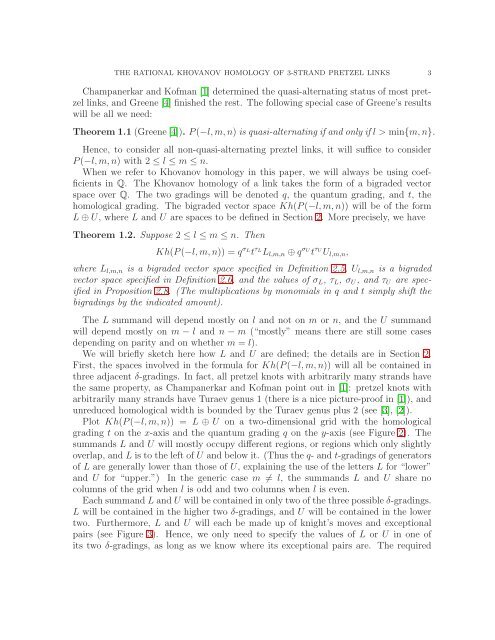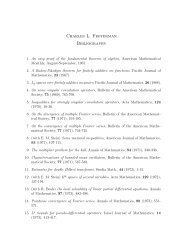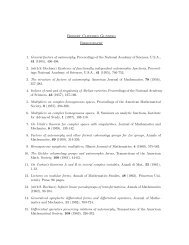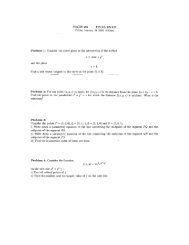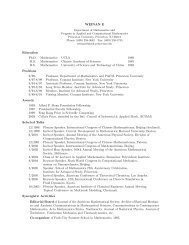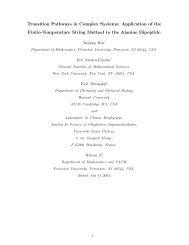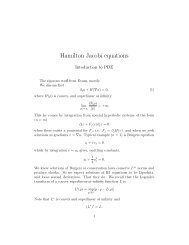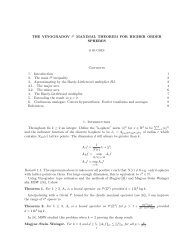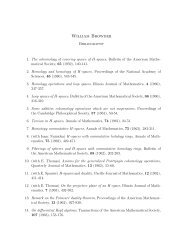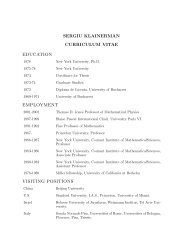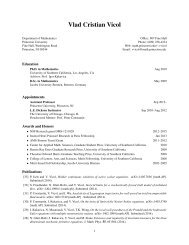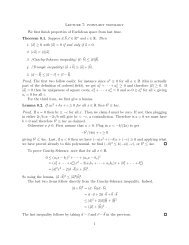The rational Khovanov homology of 3-strand pretzel links
The rational Khovanov homology of 3-strand pretzel links
The rational Khovanov homology of 3-strand pretzel links
Create successful ePaper yourself
Turn your PDF publications into a flip-book with our unique Google optimized e-Paper software.
THE RATIONAL KHOVANOV HOMOLOGY OF 3-STRAND PRETZEL LINKS 3<br />
Champanerkar and K<strong>of</strong>man [1] determined the quasi-alternating status <strong>of</strong> most <strong>pretzel</strong><br />
<strong>links</strong>, and Greene [4] finished the rest. <strong>The</strong> following special case <strong>of</strong> Greene’s results<br />
will be all we need:<br />
<strong>The</strong>orem 1.1 (Greene [4]). P(−l,m,n) is quasi-alternating if and only if l > min{m,n}.<br />
Hence, to consider all non-quasi-alternating preztel <strong>links</strong>, it will suffice to consider<br />
P(−l,m,n) with 2 ≤ l ≤ m ≤ n.<br />
When we refer to <strong>Khovanov</strong> <strong>homology</strong> in this paper, we will always be using coefficients<br />
in Q. <strong>The</strong> <strong>Khovanov</strong> <strong>homology</strong> <strong>of</strong> a link takes the form <strong>of</strong> a bigraded vector<br />
space over Q. <strong>The</strong> two gradings will be denoted q, the quantum grading, and t, the<br />
homological grading. <strong>The</strong> bigraded vector space Kh(P(−l,m,n)) will be <strong>of</strong> the form<br />
L ⊕ U, where L and U are spaces to be defined in Section 2. More precisely, we have<br />
<strong>The</strong>orem 1.2. Suppose 2 ≤ l ≤ m ≤ n. <strong>The</strong>n<br />
Kh(P(−l,m,n)) = q σ L<br />
t τ L<br />
L l,m,n ⊕ q σ U<br />
t τ U<br />
U l,m,n ,<br />
where L l,m,n is a bigraded vector space specified in Definition 2.5, U l,m,n is a bigraded<br />
vector space specified in Definition 2.6, and the values <strong>of</strong> σ L , τ L , σ U , and τ U are specified<br />
in Proposition 2.8. (<strong>The</strong> multiplications by monomials in q and t simply shift the<br />
bigradings by the indicated amount).<br />
<strong>The</strong> L summand will depend mostly on l and not on m or n, and the U summand<br />
will depend mostly on m − l and n − m (“mostly” means there are still some cases<br />
depending on parity and on whether m = l).<br />
We will briefly sketch here how L and U are defined; the details are in Section 2.<br />
First, the spaces involved in the formula for Kh(P(−l,m,n)) will all be contained in<br />
three adjacent δ-gradings. In fact, all <strong>pretzel</strong> knots with arbitrarily many <strong>strand</strong>s have<br />
the same property, as Champanerkar and K<strong>of</strong>man point out in [1]: <strong>pretzel</strong> knots with<br />
arbitrarily many <strong>strand</strong>s have Turaev genus 1 (there is a nice picture-pro<strong>of</strong> in [1]), and<br />
unreduced homological width is bounded by the Turaev genus plus 2 (see [3], [2]).<br />
Plot Kh(P(−l,m,n)) = L ⊕ U on a two-dimensional grid with the homological<br />
grading t on the x-axis and the quantum grading q on the y-axis (see Figure 2). <strong>The</strong><br />
summands L and U will mostly occupy different regions, or regions which only slightly<br />
overlap, and L is to the left <strong>of</strong> U and below it. (Thus the q- and t-gradings <strong>of</strong> generators<br />
<strong>of</strong> L are generally lower than those <strong>of</strong> U, explaining the use <strong>of</strong> the letters L for “lower”<br />
and U for “upper.”) In the generic case m ≠ l, the summands L and U share no<br />
columns <strong>of</strong> the grid when l is odd and two columns when l is even.<br />
Each summand L and U will be contained in only two <strong>of</strong> the three possible δ-gradings.<br />
L will be contained in the higher two δ-gradings, and U will be contained in the lower<br />
two. Furthermore, L and U will each be made up <strong>of</strong> knight’s moves and exceptional<br />
pairs (see Figure 3). Hence, we only need to specify the values <strong>of</strong> L or U in one <strong>of</strong><br />
its two δ-gradings, as long as we know where its exceptional pairs are. <strong>The</strong> required


